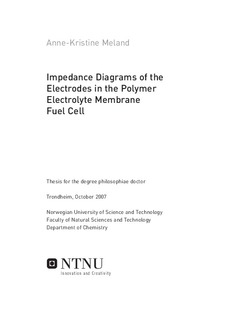| dc.contributor.author | Meland, Anne-Kristine | nb_NO |
| dc.date.accessioned | 2014-12-19T13:20:31Z | |
| dc.date.available | 2014-12-19T13:20:31Z | |
| dc.date.created | 2007-10-22 | nb_NO |
| dc.date.issued | 2007 | nb_NO |
| dc.identifier | 122818 | nb_NO |
| dc.identifier.isbn | 978-82-471-3943-1 | nb_NO |
| dc.identifier.uri | http://hdl.handle.net/11250/247427 | |
| dc.description.abstract | The objective of this thesis was to better understand the electrodes of the polymer electrolyte membrane fuel cell (PEMFC), and especially the anode. We were interested in how CO poisoning affected the fuel cell and therefore we started by looking at the unpoisoned anode. It was important to get a good understanding of the mechanisms of the unpoisoned electrode to have a good background to understand the poisoned one.
The electrodes were investigated using in situ electrochemical impedance spectroscopy (EIS). The cell studied in all experiments consisted of two similar E-TEK Elat gas diffusion electrodes (Elat/Std/DS/V2) with 0.5 mg/cm2 Pt loading and 20% Pt/C. The electrodes were sprayed with a 5 wt% Nafion solution to give 0.6 mg/cm2. The two electrodes were separated by a Nafion 117 membrane. A two electrode set-up was used in all the experiments. Symmetric cells were used, H2|H2 and O2|O2, to avoid using a reference electrode. In addition, experiments with the whole fuel cell, H2|O2, were done. The frequency range used in the EIS experiments was 10 kHz-10 mHz. The operating temperatures were 30 and 50ºC.
We started out by investigate the unpoisoned anode using EIS and a symmetrical hydrogen cell, and we discovered the Gerischer behaviour in the low frequency area. This showed that hydrogen difuused along the carbon pores in the electrode and that the adsorption reaction took place in combination with surface difuusion of hydrogen in the carbon layer located before the platinum surface. The reaction was thus not only dependent of the platinum catalyst particles. We were not able to distinguish between molecular or atomic adsorption. The relaxation time for this rate-limiting adsorption/diffusion step was independent of bias voltage. In Chapter 2 we show the results for this Gerischer phase element and included this in the equivalent circuit. The equivalent circuit consisted of two rate-limiting steps, one charge transfer step taking place at the platinum particles and one adsorption/diffusion step. The equivalent circuit was determined from irreversible thermodynamics.
We discovered a third rate limiting step at the anode. The third step was the proton hydration step. In Chapter 3 we show that water plays an important role at the anode. The arc was seen at the highest frequencies in the Nyquist diagram. This third step was best seen at the low temperature, 30ºC, at 50ºC this small arc was superimposed on the charge transfer arc in the Nyquist plot. Again we saw the Gerischer behaviour. An equivalent circuit with three rate limiting steps was determined using irreversible thermodynamics. The surface coeficient of hydrogen diffusion was estimated to 10−7 m2/s.
In Chapter 4, we saw how the anode and the whole fuel cell reacted when 103 ppm carbon monoxide (CO) was introduced in the fuel gas. Bias voltages of 0 and 0.05 V were used. Three steps were again revealed in the reaction mechanism, the charge transfer step, the adsorption/diffusion step, and the proton hydration step. This confirmed earlier results from the unpoisoned anode. The CO had a big effect on the charge transfer step and the relaxation time increased drastically. The relaxation time for the adsorption/diffusion step was unaffected by the CO. We also concluded that CO reduces the diffusion
rate of the surface diffusion of hydrogen on carbon. Also the relaxation time for the proton hydration step was unaffected by CO. CO hindered hydrogen access to the Pt surface, occupied the Pt surface and made the surface more polarisable. These results supported the results from the two previous chapters. From cyclic voltammetry and stripping voltammetry experiments we found the CO coverage to be 0.90 at 30ºC and 0.85 at 50ºC.
In Chapter 5 we looked at the oxygen electrode and the oxygen reduction reaction (ORR). A symmetric oxygen cell was investigated both in the potentiostatic and galvanostatic mode. The oxygen electrode was not reversible and the whole fuel cell was also investigated at the same conditions as the symmetric oxygen. The anodic and cathodic contribution of the oxygen electrode were then discovered. We found two rate-limiting steps. One dominating arc in the Nyquist diagram related to the charge transfer reaction and one small high frequency arc that we assigned to a proton dehydration step. This small high frequency arc did not change with the bias voltage. We believe we had peroxide formation followed by decomposition of peroxide. The Butler-Volmer equation was also fitted to the experimental data. The transfer coefficient β was determined to 0.70 ± 0.03 and the exchange current density, j0 was (9.42±0.01)10−5 A/cm2. | nb_NO |
| dc.language | eng | nb_NO |
| dc.publisher | Fakultet for naturvitenskap og teknologi | nb_NO |
| dc.relation.ispartofseries | Doktoravhandlinger ved NTNU, 1503-8181; 2007:179 | nb_NO |
| dc.relation.haspart | Meland, Anne-Kristine; Bedeaux, Dick; Kjelstrup, Signe. A Gerischer phase element in the impedance diagram of the polymer electrolyte membrane fuel cell anode. J. Phys. Chem B. 109(45): 21380-21388, 2005. | nb_NO |
| dc.relation.haspart | Meland, Anne-Kristine; Kjelstrup, Signe. Rate limiting proton hydration in the anode of the polymer electrolyte membrane fuel cell. J. Mem. Sci. 282: 96-108, 2006. | nb_NO |
| dc.title | Impedance Diagrams of the Electrodes in the Polymer Electrolyte Membrane Fuel Cell | nb_NO |
| dc.type | Doctoral thesis | nb_NO |
| dc.contributor.department | Norges teknisk-naturvitenskapelige universitet, Fakultet for naturvitenskap og teknologi, Institutt for kjemi | nb_NO |
| dc.description.degree | PhD i kjemi | nb_NO |
| dc.description.degree | PhD in Chemistry | en_GB |
